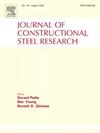Response modification factor of high-strength steel frame-tube structures with replaceable shear links
IF 4
2区 工程技术
Q1 CONSTRUCTION & BUILDING TECHNOLOGY
引用次数: 0
Abstract
In high-strength steel frame-tube structures with replaceable shear links (HSS-FTS-LSL), shear links made of low-yield point steel are placed in the center of deep beams, while the beams and columns are constructed using high-strength steel. During seismic activity, these shear links yield to dissipate energy, while the deep beams and columns either remain elastic or only partially enter the plastic range due to the use of high-strength steel. To investigate the response modification factor of HSS-FTS-LSL structures, three sets of twelve buildings were designed, with variations in the number of floors, the length of the shear links, and their arrangement. An improved pushover analysis method, using a distributed lateral force adjustment approach, was employed to account for the impact of higher modes. The response modification factor (R) and displacement amplification factor (Cd) for each of the twelve buildings were then calculated using the enhanced capacity spectrum method. The effects of the number of floors, shear link length, and their arrangement on the response modification factors were also studied. Based on these findings, recommended values for R-factor and Cd-factor are provided. Additionally, a modified design response spectrum was proposed. One of the HSS-FTS-LSL buildings was redesigned following this proposed seismic design response spectrum, and nonlinear dynamic analyses were conducted on both the original and redesigned structures. The comparison of seismic performance and steel usage between the two designs confirmed the accuracy of the suggested R-factor and Cd-factor values in this study.
求助全文
约1分钟内获得全文
求助全文
来源期刊

Journal of Constructional Steel Research
工程技术-工程:土木
CiteScore
7.90
自引率
19.50%
发文量
550
审稿时长
46 days
期刊介绍:
The Journal of Constructional Steel Research provides an international forum for the presentation and discussion of the latest developments in structural steel research and their applications. It is aimed not only at researchers but also at those likely to be most affected by research results, i.e. designers and fabricators. Original papers of a high standard dealing with all aspects of steel research including theoretical and experimental research on elements, assemblages, connection and material properties are considered for publication.
 求助内容:
求助内容: 应助结果提醒方式:
应助结果提醒方式:


